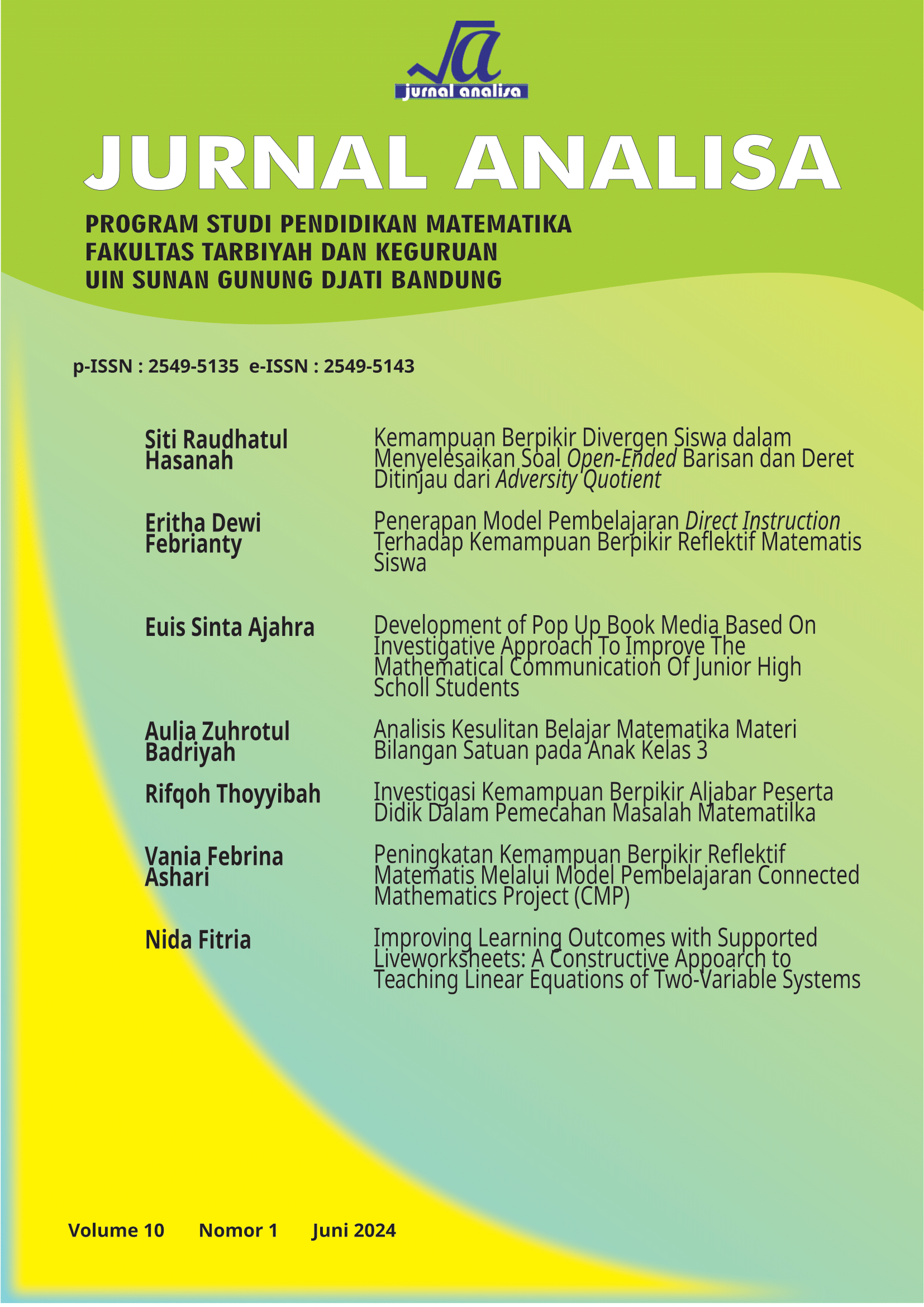Development of Pop Up Book Media Based on an Investigative Approach to Improve The Matematical Communication Skill of Junior High School Students
DOI:
https://doi.org/10.15575/ja.v10i1.34699Keywords:
Media Development, Pop-Up Book, Mathematical Communication SkillsAbstract
Siswa SMP sering mengalami kesulitan dalam memahami konsep matematika yang abstrak dan membutuhkan bantuan visual dalam proses pembelajaran. Pengembangan media buku pop-up berbasis pendekatan investigasi bertujuan memberikan representasi visual dari konsep matematika. Penelitian ini bertujuan menilai validitas, praktikabilitas, dan efektivitas media buku pop-up berbasis pendekatan investigasi serta mengukur peningkatan kemampuan komunikasi matematis siswa sebelum dan setelah menggunakan buku pop-up. Metode penelitian yang digunakan adalah Penelitian dan Pengembangan (R&D) dengan menggunakan model 4D (define, design, develop, and disseminate). Hasil penelitian menunjukkan bahwa media ini sangat valid dari segi media dan materi. Praktikabilitas media ini dinilai sangat praktis, dan efektivitasnya diklasifikasikan sebagai sangat tinggi. Terdapat peningkatan yang signifikan dalam kemampuan komunikasi matematis siswa, yang dikategorikan sebagai tinggi.
Â
Junior high school students often struggle with grasping abstract mathematical concepts and benefit from visual aids in their learning process. The development of investigative-based pop-up book media aims to provide visual representations of these concepts. This research aims to assess the validity, practicality, and effectiveness of the investigative-based pop-up book media and to measure the improvement in students' mathematical communication skills before and after using the pop-up book. The research methodology employed is Research and Development (R&D) using the 4D model (define, design, develop, and disseminate). The results indicate that the media is highly valid in terms of both media and content aspects. Its practicality is rated as highly practical, and its effectiveness is classified as very high. There is a significant improvement in the mathematical communication skills of junior high school students, categorized as high.
References
Basir, M. A., & Aminudin, M. (2020). Pengembangan Buku Teks Matematika berbasis Investigasi untuk Meningkatkan Penalaran Aljabar. Journal of Medives: journal of Mathematics Education IKIP Veteran Semarang.
Bastow, B., Hughes, J., Kissane, B., & Randall, R. (1984). Another 20 mathematical investigational work. perth:the mathematical association of western Australia (MAWA).
Chung, Y., Yoo, J., Kim, S.-W., Lee, H., & Zeidler, D. (2016). Enhancing students’ communication skills in the science classroom through socioscientific issues. International Journal of Science and Mathematics Education, 1-27.
Cockcroft, W. H. (1986). Mathematics Counts. London: HMSO.
Dyk, S. V., & Cooper-Hewitt. (2011). Paper Engineering: Fold, Pull, Pop & Turn. Washington, DC: The Smithsonian Libraries Exhibition Gallery, National Museum of American History.
Dzulhikmah, U. (2017). Pengembangan Media Pop-Up Book Menggunakan Pendekatan saintifik untuk Siswa Kelas VII Pada Materi Segitiga. Skripsi.
Greenes, C., & Schulman, L. (1996). Communication Processes in Mathematical Explorations and Investigations. In P. C. Elliot, & M. J. (Eds), Communication in Mathematics, K-12 and beyond (pp. 159-169). USA: NCTM.
Jihad, A., Aan Lasmanah, dan, Djati Bandung, G., Negeri, S., & Bandung, S. (2019). Pembelajaran Matematika Berbasis Android untuk Meningkatkan Kemampuan Komunikasi Matematika di SMP. Jurnal Analisa, 5(2), 199–205. http://journal.uinsgd.ac.id/index.php/analisa/index.
Johnson, R. B., & Miles, M. S. (2018). Enhancing Geometry Learning with Pop-Up Books. Mathematics Education Review, 22(3), 98-112.
Kariadinata, R., Juariah, J., Hidayat, R., & Sugilar, H. (2019). Kemampuan komunikasi dan pengelolaan kelas calon guru matematika. Jurnal Analisa, 5(1), 68–83. https://doi.org/10.15575/ja.v5i1.4826.
Khusna, I. (2020). Pengembangan Pop-Up Book Bentuk Aljabar Berbasis Investigasi Matematis di SMP. Skripsi.
Lee, H., & Anderson, J. (2019). Investigative Approaches in Mathematics Education: Benefits and Implementation. Journal of Mathematics Education, 32(1), 45-59.
Lizuka, S., Endo, Y., Mitani, J., kanamori, Y., & Fukui, Y. (2011). An Interactive Design System for Pop-Up Cards With A Physical Simulation. Vis Comput, 605-612.
Nailul, Sunardi, & Sugiarti. (2013). Analisis Soal Ujian Nasional (UN) Matematika SMK Tahun Ajaran 2011/2012 Berdasarkan Taksonomi. Jurnal Pancaran Pendidikan.
Nancy, L. B., & Rhonda, H. T. (2012). Pop-Up Books: A Guide for Teachers and Librarians. California: Santa Barbara.
Okamura, S., & Igarashi, T. (2010). An Assistant Interface to Design and Produce a Pop-Up Card. International Journal of Creative Interfaces and Computer, 1(2),, 40-50.
Oktaviana, D., Prihatin, I., & Fahrizar, F. (2020). Pengembangan Media Pop-Up Book Berbasis Contextual Teaching and Learning dalam Pencapaian Kemampuan Pemecahan Masalah.
Setiawan. (2006). Kelebihan & Kekurangan Pembelajaran Group Investigation. Retrieved from 9online: http//discussion-lecture.blogspot.com/2006/09/kelebihan-dankekurangan-pembelajaran-group-investigaton.html.
Sugiyono. (2017). Metode Penelitian Pendidikan. Bandung: Alfabeta.
Smith, J. A., & Brown, L. K. (2015). The Use of Pop-Up Books in Education. Journal of Educational Media, 40(2), 123-134.
Suherman, N. (2016). Upaya Meningkatkan Kemampuan Berpikir Geometri Van Hiele Siswa SMP Melalui Model Pembelajaran Example Non Examples. Jurnal Analisa, 2(4). http://journal.uinsgd.ac.id/index.php/analisa/index.
Trianto. (2009). Mendesain model pembelajaran inovatif progresif konsep, Landasan Dan Implementasi Pada Kurikulum Tingkat satuan Pendidikan. Jakarta: Kencana Prenada Group.
Villanueva, V. R., Penuela, E., Ollero, A., Herrero, A. D., Caetano, D., Gutierrez, I., . . . Stoffel, M. (2015). Percepcion Post-Crecida De Los Restos De Vefetacion En Cauces De Montana De La Peninsula Iberica. River perception and education.
Downloads
Published
Issue
Section
License
Authors who publish in Jurnal Analisa agree to the following terms:
1. Authors retain copyright and grant the journal right of first publication with the work simultaneously licensed under a Attribution-ShareAlike 4.0 International (CC BY-SA 4.0) License that allows others to share the work with an acknowledgment of the work's authorship and initial publication in this journal.
2. Authors are able to enter into separate, additional contractual arrangements for the non-exclusive distribution of the journal's published version of the work (e.g., post it to an institutional repository or publish it in a book), with an acknowledgment of its initial publication in this journal.
3.Authors are permitted and encouraged to post their work online (e.g., in institutional repositories or on their website) prior to and during the submission process, as it can lead to productive exchanges, as well as earlier and greater citation of published work (See The Effect of Open Access).
